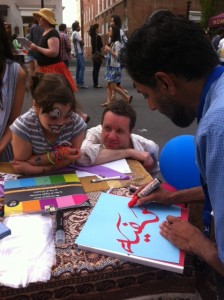A History & Practice of Arabic Calligraphy, Rutgers University 2015
Course Title: An Introduction to the History and Practice of Arabic Calligraphy
 Course Description: The course will introduce students to the history and practice of Arabic calligraphy and calligraphic art. This course will take students on a historical journey through different time periods and lands where written Arabic flourished. Students will be exposed to different forms of Arabic lettering to examine a majestic art form that flourished not only to beautify the Quran but elementary in architecture and home décor. In addition, the class will expose students to contemporary direction for Arabic Calligraphy as an expressive art in the West and a case for the American script. The ability to read and write Arabic is not a prerequisite to take this course. Students will learn the use of traditional and modern tools for Arabic script.
Course Description: The course will introduce students to the history and practice of Arabic calligraphy and calligraphic art. This course will take students on a historical journey through different time periods and lands where written Arabic flourished. Students will be exposed to different forms of Arabic lettering to examine a majestic art form that flourished not only to beautify the Quran but elementary in architecture and home décor. In addition, the class will expose students to contemporary direction for Arabic Calligraphy as an expressive art in the West and a case for the American script. The ability to read and write Arabic is not a prerequisite to take this course. Students will learn the use of traditional and modern tools for Arabic script.
- 3 credits
Instructor: Faraz Khan
Day/Time: MWF, 6:00pm-9:55pm
College Avenue (Room and building TBD)Enrollment Cap: 15
- This course will run from May 26, 2015 – June 19, 2015.
Course Objectives:
- Understand the diversity and development of a writing style across time and place.
- Identify and decipher different scripts by utilizing different script theories, methodologies, and cultures.
- Synthesize and be able to artistically express the development of the scripts.
- Create specific form and flow of letters and words using traditional and modern tools of writing.
- Explore new themes and design elements to discover a well-balanced art form.
Course: Arabic Calligraphy
- Course # 01:685:395 Section A6
Special Topics in Middle Eastern Stdys – Intro to the History and Practice of Arabic Calligraphy
- Cross-listed with – course number 01:013:301:A6
- Please note AMESALL has agreed to cross-list this course (which should help enrollment).
